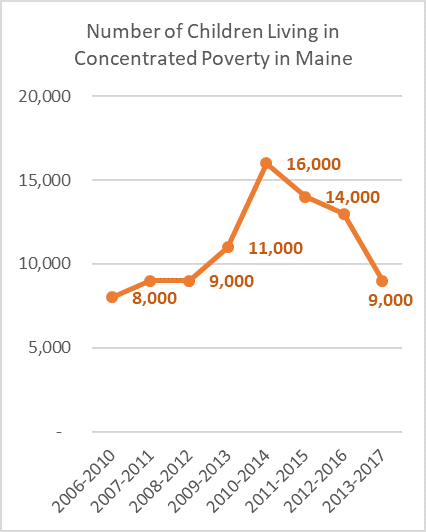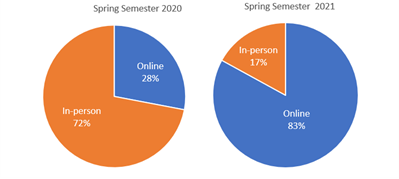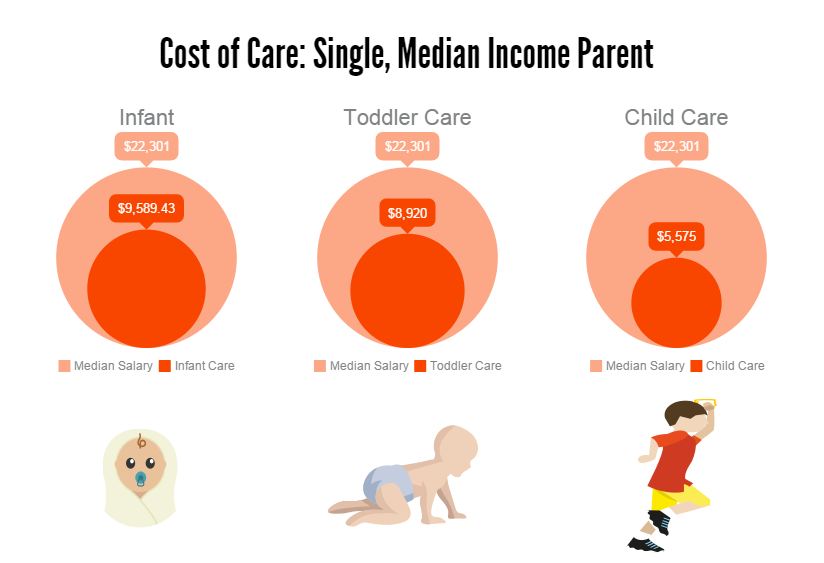Percentage of Children Living in Concentrated Poverty in Maine Remains Below National Averages
mainechildrensalliance • September 24, 2019

Children Living in High-Poverty, Low-Opportunity Neighborhoods
Why concentrated poverty is important
 What does concentrated poverty look like in Maine
What does concentrated poverty look like in Maine
The percent in poverty data is 1 year data and the concentrated poverty is 5 year data, so the 19-27% is the range depending on the year.
1
Concentrated poverty exists at a higher rate in Maine’s five largest cities
| 2008-2012 | 2013-2017 | |||
| Living in concentrated poverty | # children | %children | # children | %children |
| Maine- principal cities*: Portland, South Portland, Lewiston, Auburn and Bangor | 8,000 | 20 | 7,000 | 19 |
| Maine Metro, outside city limits in York, Cumberland, Androscoggin, Sagadahoc and Kennebec Counties | 1,000 | <.5% | 1,000 | 1 |
| Maine Non-metro (10 rural counties) | 1,000 | 1 | 2,000 | 2 |
*The principal city category includes geographic areas that are the principal city of a metropolitan statistical area (MSA). In Maine, the principal city category includes children living in the cities of Bangor, Auburn, Lewiston, Portland, and South Portland.
There have been no changes in rates by race for concentrated poverty by race
in Maine
Most children living in concentrated poverty neighborhoods in Maine are not
living in immigrant families, but children in
immigrant families were three times more likely to live in concentrated poverty neighborhoods than children living in non-immigrant families
“Solutions to uplift these communities are not far out of reach, and they would have significant positive effects both for children and youth and for our country as a whole,” said Scot Spencer, associate director of advocacy and influence at the Casey Foundation. “Strong neighborhoods foster stable families and healthy children.”
1. Sharkley, P. (2009). Neighborhoods and the Black-White Mobility Gap. Washington, D.C.: The Pew Charitable Trusts

By mainechildrensalliance
•
July 15, 2025
Maine’s college students – like students of all ages – had their learning disrupted by the COVID-19 crisis. The impact on college enrollment in Maine reflects the trends nationally. Maine’s public university and community college systems have played a critical role in addressing the needs of students and American Rescue Act funds offer an opportunity for continued support to students to help them succeed in meeting their higher education goals.
By mainechildrensalliance
•
July 15, 2025
AUGUSTA, ME—On Tuesday the President released his blueprint for the federal budget , which if enacted, would be detrimental to Maine’s future and the health and well-being of our children, youth and families. The President’s proposals go back on the Federal Government’s long-held commitments to children in the areas of health, nutrition and education. These drastic cuts targeting programs like Medicaid, the Children’s Health Insurance Program (CHIP) and the Supplemental Nutrition Assistance Program (SNAP) will adversely affect child development in Maine and there will be serious consequences for years to come.
By mainechildrensalliance
•
July 15, 2025
Through the Maine state budget, we can support solutions that respond to the needs of the moment and invest in building a more vibrant, equitable future for our children. an unprecedented opportunity to strengthen and stabilize families who continue to face significant health and economic challenges related to the coronavirus pandemic. They also provide an opportunity to invest in the long-term recovery of our state, by investing in the programs and services that support the needs of working families, who are raising the next generation of Mainers, and who are the backbone of our workforce and communities.
By mainechildrensalliance
•
July 15, 2025
the American Health Care Act
By mainechildrensalliance
•
July 15, 2025
By mainechildrensalliance
•
July 15, 2025




